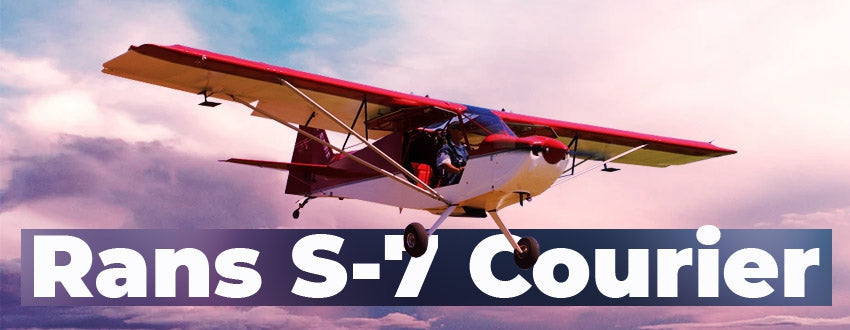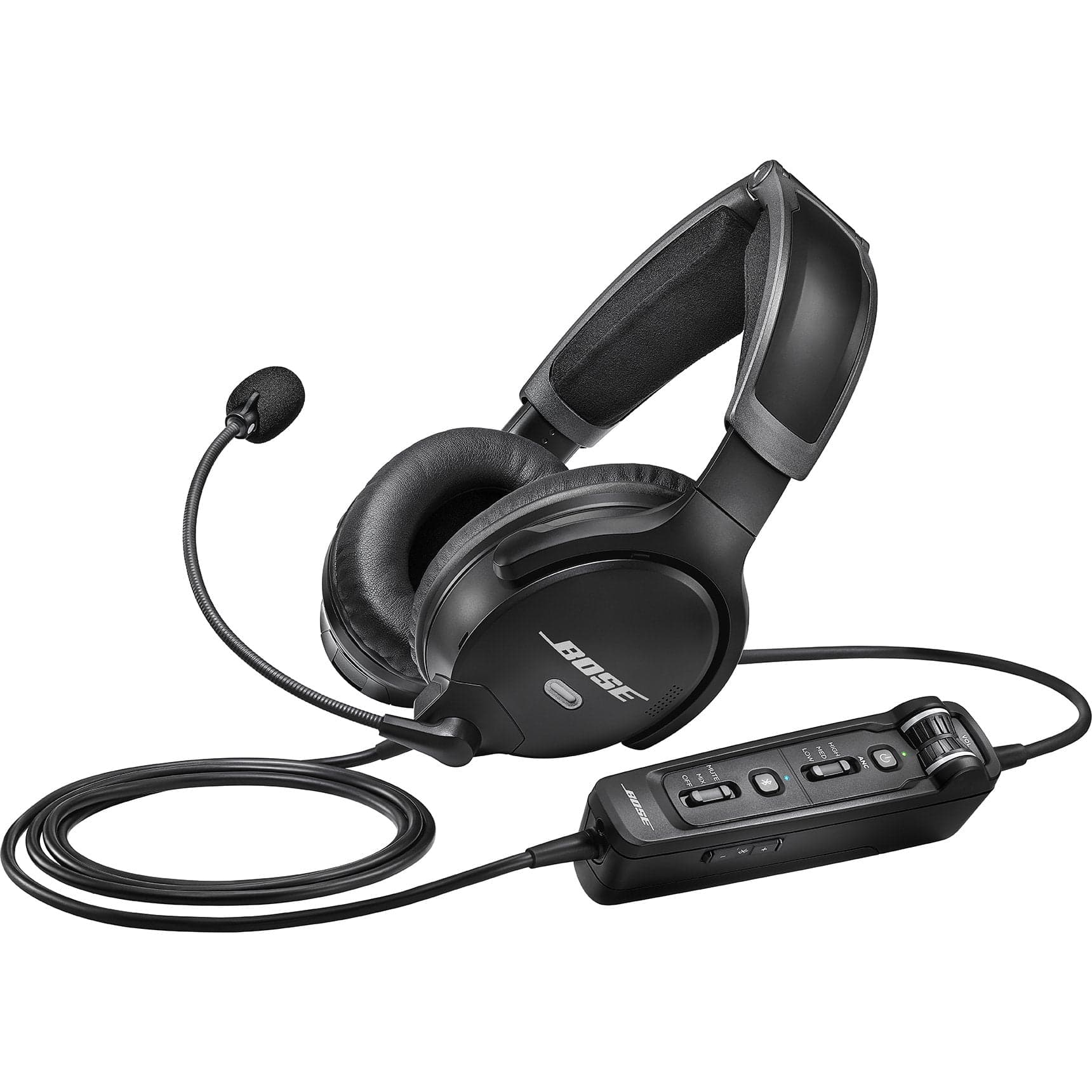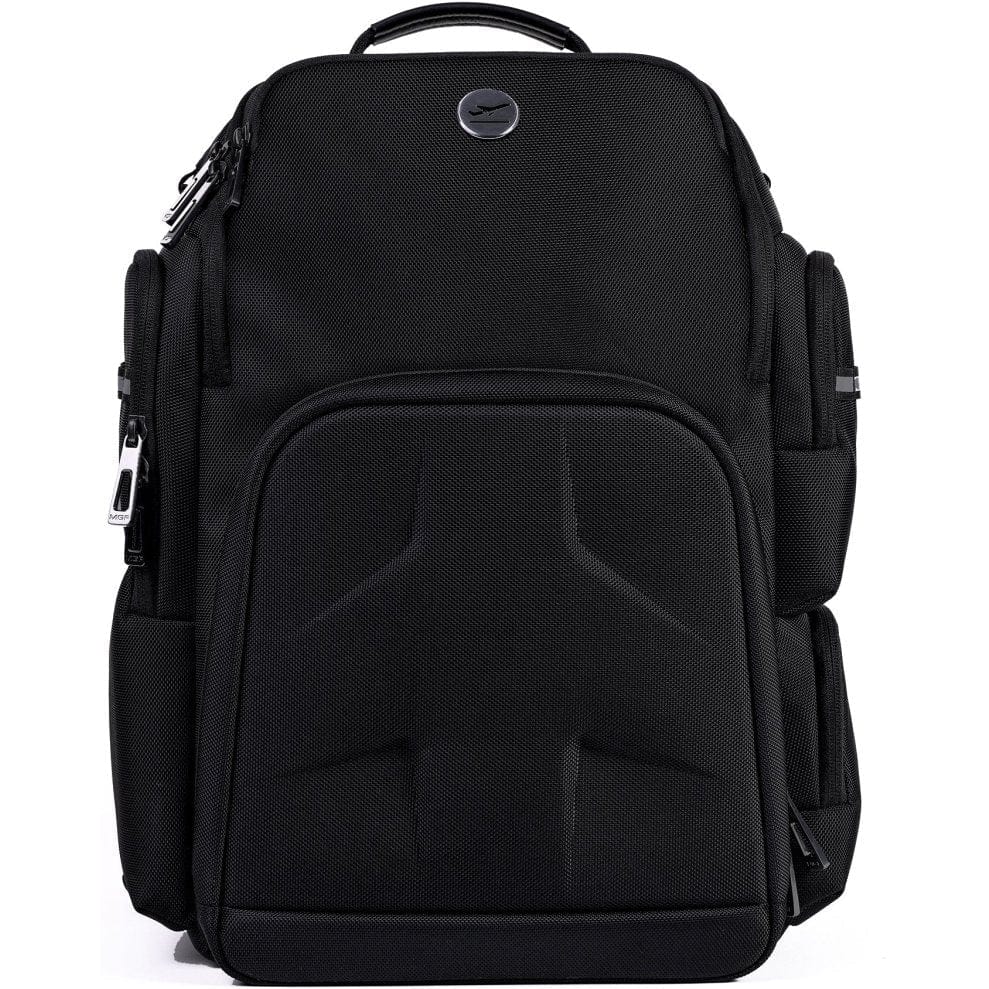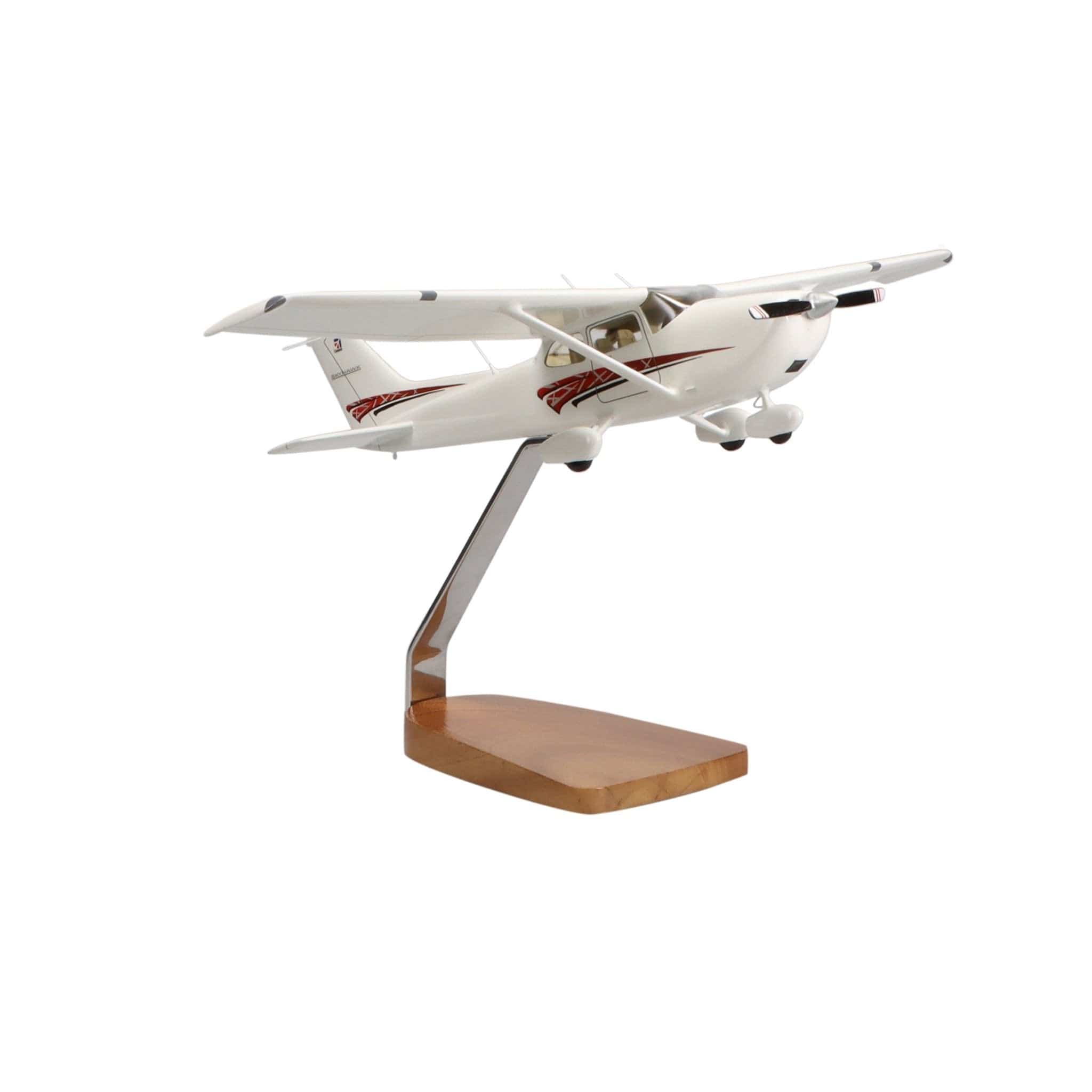“Little planes with big personalities.” This is how AOPA describes the RANS Aircraft family of planes. One of the standout features of the RANS family is the uniqueness of each line.
The S-21 Outbound has a different purpose than the S-20 Raven which feels unique compared to the S-19 Venterra or the S-7 Courier.
The S-7 Courier, is one of RANS best-selling aircrafts, has made its mark as an economical, rugged, STOL-friendly, two-place light sport aircraft whose design has been steadily and lovingly improved over the years since its initial release.
If you're interested in learning more about the RANS S7 bush plane, come along with us as we delve into the history and specifications of this amazing aircraft.
History of RANS Aircraft

RANS Aircraft got its start in 1974 selling sail trikes and nonpowered land yachts. Founder Randy Schlitter created the company name as a blend of his own first and last names.
Based out of Hays, Kansas, RANS did well in the sail trike and racing business. Then in the early 1980s, Schlitter tried hang gliding. He absolutely loved the experience but was not satisfied with the selection of ultralight aircraft on the market at the time. Randy saw an opportunity and he went for it.
Drawing on his experience with sail trikes, Schlitter first considered designing an ultralight sailplane, but ultimately opted to work on an ultralight aircraft instead.
Schlitter’s first ultralight design and prototype were completed in 1982, and he founded a company called Aero-Max to handle production. After Aero-Max closed due to financial hardships, RANS became both the designing and production company.
The RANS S-4 Coyote
The RANS S-4 Coyote hit the market in 1983 and was well received, but Schlitter did not stop there. He kept dreaming up and designing new planes through 2006 when RANS Aircraft had 12 designs all simultaneously in production.
Around this time, with the FAA’s new Light Sport Aircraft rule coming into full implementation, Schlitter decided to end production on many of the lines and narrow his company’s focus.
He homed in on the light-sport aircraft market. The S-7 Courier line was one that made the cut and continues to be offered to eager and grateful pilots.
Designing the RANS S-7 Courier
The S-7 Courier got its start as a trainer for the S-4 Coyote. Since the Coyotes are single place planes, pilots had no way of taking an instructor up with them.
Schlitter saw the need for a two-place plane with the same control configuration as the Coyote so that pilots could use the new plane as a trainer.
He wanted this plane to be simple, streamlined, and utilitarian, providing all the functionality that pilots would want at an affordable price point.
In 1985, two years after the Coyote was released, the two-place S-7 Courier made its debut. Like the Coyote, the throttle quadrant on the Courier is located to the lower left of the pilot and the stick is in the middle.
The Courier was built with standard landing gear, but it can be outfitted with floats and skis.

Key Design Features of the RANS S-7 Courier
The design focus of the S-7 Courier is on reliability, economy, functionality, and meeting the needs of the owner pilots. Some of the key design features you can expect to find in a RANS S-7 plane are:
Exceptional Low Speed Handling
The S-7 is built for performance at all speeds, and it demonstrates great stability and handling characteristics. RANS credits “the right portions and shapes” of the tail design for the S-7s particularly excellent low-speed performance.
Roomy Cabin
Not all light sport planes are designed for pilots more than 6 feet tall, but the S-7 is. RANS assures prospective pilots that the Courier can comfortably accommodate two full-size adults and that pilots from 5 feet to 6 feet 7 inches have fit into an S-7.
Control Harmony
One of Randy Schlitter’s core beliefs about aircraft design is that careful calculations to achieve control harmony are important, even in the light sport market. RANS takes a reasoned, nuanced approach to achieving this control harmony.
Rather than simply making aileron forces equal to pitch forces, RANS planes compensate for the human factor. Since most pilots will subconsciously apply greater force while pushing or pulling, the pitch forces on a RANS plane are set slightly higher.
Aileron forces are set slightly lower as pilots will inherently apply less pressure side-to-side. The result is control forces which are technically slightly off, but which will feel equal to the pilot.
Operational History of the RANS S-7 Courier
By 2011, over 600 S-7 and S-7 variant planes had been built, and RANS took all the builder feedback into consideration. Although the variant names have not changed with each improvement that RANS makes to the design, there have been plenty of upgrades both company and builder generated.
An example of this responsiveness to builder feedback is the fuel tank revisions on the 2012 model of the S-7S. When speaking to Kit Planes about the updates, Randy said that he and the team had thought, “18 gallons was plenty of fuel! But the builders want more, and we were able to give it to them.”
The larger 26-gallon tanks were made possible by installing lighter, high-capacity roto-molded tanks that are contoured to the airfoil.
At Sun ‘n Fun 2015, RANS unveiled 10 major improvements to the S-7 Courier. Schlitter noted, “Almost all of these items we did was to increase builder friendliness, decrease build time.”
The Rotax ring mount was installed in the nose of the plane so that builders could now outfit the Courier with any of the 900-series Rotax engines. This upgrade is retrofittable to prior S-7s.
The landing gear was simplified into a two-piece externally mounted aluminum spring gear that bolted to the frame and could be adjusted for camber and trail.
The gear was also moved 3 inches forward and spread an additional 10 inches. The plane was raised by 4 inches for improved clearance.
The 2015 and the newer Rans S7 also comes with a simplified flexible line fuel system complete with a header tank for compatibility with fuel-injected engines. The flexible lines facilitated the option of swiveling and swinging the wings back for ease of storage.
In the cabin, the control stick system shifted from a 1-1/2” steel construction to a 2” aluminum for simplicity of install and to decrease the empty weight of the craft.
The rear stick was redesigned to be removable, based in part as Schlitter shares, on the request of people in Alaska who, “had this crazy idea of loading up the back seat with a chopped-up moose.”
More baggage compartment room is also gained by the swing up design of the rear seat and the redesigned baggage compartment bracing system that allows for improved ease of access.
Multiple S-7, S-7 variant, and other RANS aircraft have won awards and are featured on the list of award winning RANS. Awards won by the S-7 family include SERFI 2010 Custom Built Tube and Fabric Champion and SERFI 2013 Light Sport Champion.
Building and Flying the RANS S-7 Courier
Randy describes the S-7 as “a very capable bush plane, a very capable touring plane, a very pleasant to fly plane.” He likens the Courier to a Swiss Army knife saying, “It does so many things well.”
Pilot and builder Reid McCall agrees. When interviewed by Ultralight Flyer, McCall shared that prior to purchasing is S-7, he did his research and he really liked the quality of the airplane and the tandem seating.
He had previously owned and built a Zenair and a Champ. “The engineering is easy,” McCall says of the S-7. “The company promises they are right out of the box and they are. They are very easy. The hardest part is the fabric work. Once the fabric work is done, it’s so easy to put together.”
McCall, who built his S-7 in a two-car garage, says that the fabric work and paint are the little details that make the plane’s look. Assembly is done using a combination of pop rivets and bolts.
McCall says that the instructions from RANS were perfect and easy to follow plus videos and online helped make the build process simple. “It’s a very good company to deal with,” he says. The build process took McCall an estimated 1,000 hours spread out over a period of 2 years.
When it comes to real world performance, McCall says that he is getting 100 mph cruising speed, an 800 feet per minute rate of climb with two occupants, and he can land at 45 mph.
McCall estimates that his 18 gallons of fuel can safely provide him with 3 and a half hours of flight time, but to be conservative, he opts for legs that are no more than 3 hours in length.
McCall loves his S-7 so much that he actually purchased a second kit after selling his Zenair and Champ. The plan is to outfit the second S-7 with amphibious floats and the Rotax 914 engine.
Other pilots cite the ample leg and elbow room, tandem configuration, and generous baggage capacity as reasons to purchase the S-7.
The S-7 series are popular with pilots looking for a kit build STOL plane. One of the favorite mods that bush pilots like to do is to add vortex generators or VGs. The VGs soften landings, decrease the stall speed, and enhance the forgiving nature of the S-7s stall characteristics.
Some back-country pilots do note that they wish the S-7 had a nosewheel rather than tail-dragger configuration as the taildragger can get caught in the bush. RANS notes that pilots wanting a “more extreme STOL plane” can opt for the Monster Gear option.
The flat leaf aluminum spring gear absorbs the shock on landing with half the recoil of the traditional steel leaf gear.
Variants of the RANS S-7 Courier
Since the original S-7 was released in 1985, it has given birth to three other variants, two of which are still available today. The variants include pre-built factory-assembled models as well as FAA-certified kit versions that pilots can build themselves.
S-7
The original S7 released in 1985 was designed to be powered by a 50 hp Rotax 503 engine with the option to upgrade to a 65 hp Rotax 582. The first version of the S-7 weighed just 390 pounds. In the mid-1990s, the fuselage was extended to help with stability.
S-7C
In 2001, RANS obtained FAA primary category certification for the S-7 – a certification that was seven years in the making. The S-7C model (with the C standing for certified) underwent some design changes to meet the certification standards.
One of the biggest changes was the addition of an electric fuel pump which also became standard on the subsequent S-7S and S-7LS variants.
To be primary category certified, the FAA requires aircraft to be “of a simple design and intended exclusively for pleasure and personal use.”
The FAA also notes that these aircraft “must be manufactured under a production certificate.” This means that the S-7C is delivered pre-built by RANS under their supervision and quality control system per FAA standards.
S-7S
Two years after the upgraded S-7C came on the market, the kit version was also released. Designated the S-7S, the 51% kit version qualifies as an Experimental light-sport aircraft (ELSA) and comes standard with the 100 hp Rotax 912ULS engine. The S-7S variant is still in production and available directly from RANS Aircraft.
The maximum gross weight for the S-7S was raised by 20 pounds to match the LSA maximum of 1,320 pounds. Builders can also upgrade to carbon-fiber construction for the wingtips, cowling, spinner, and boot cowl to decrease the aircraft’s empty weight by 15 pounds and further maximize useful load.
There are two versions of the S-7S kit available. RANS initially said that the quick build version should take about 250-350 hours to build while the standard option usually takes 500-700 hours.
It is worth noting that pilots who built the standard kit often commented that a more realistic build time estimate would be 700-1,000 hours and the latest information on the RAMS website concurs with this more generous real-world estimate.
S-7LS
The second variant still on the market today is the factory-assembled S-7LS. This special light-sport aircraft (SLSA) model has the same specs as the S-7S, but it comes pre-built and ready to fly rather than in a kit.
On the S-7LS variant, the fins, trim tabs, elevator, and stabilizer sizes were all increased to improve vertical axis stability. An additional 18-inches was added to the tail length for the same reason.
Purchasing an S-7 Courier
When you are ready to purchase your own S-7 Courier, RANS can help set you up with either a pre-owned or new aircraft. The pre-owned S-7 planes listed by owners and hosted on the RANS website currently range from $39,900 for an original variant 1992 S-7 to $109,000 for an S-7S with 164 hours on it.
Pilots who would prefer a new aircraft have two choices: the S-7S Courier build kit or the S-7LS ready to fly factory-assembled plane.
The current base price for the kit is $29,500 less firewall forward plus $6,000 for the Rotax 912ULS engine install kit and an unlisted amount for the engine itself. Contact RANS directly for current engine pricing. The ready-to-fly S-7LS plane has a base price of $145,000 inclusive of all standard equipment.
For both aircraft, additional options are available depending on your wants and needs. Pilots can upgrade to a deluxe digital navigation panel, enhanced lighting package, tundra or bush tires, specialty paint schemes and more.
Both S-7 variants come standard with a wave stripe paint scheme in one of 3 colors. A swoop or premium scheme may be substituted for an additional charge. Custom schemes are also available by quote.
For pilots looking to build their Courier a bit at a time, RANS offer partial kits. You can purchase a wing kit, fuselage and tail kit, covering kit, or finishing kit as stand-alone items to spread your build cost out over time.
Whichever route you go, one of the most exciting things about choosing a RANS plane is that Schlitter and team remain focused on development and pushing each existing model forward to its ultimate potential.
As Schlitter shared with Kit Planes, “We want to keep things interesting. There are always things we can do better, ways to make the kit easier to build or take weight out of the airplane.” Clearly there is no stagnation at RANS.

(source: www.rans.com )
RANS S-7 Courier Specifications
- Engine: Rotax 582
- Horsepower: 65
- Propeller: 2-blade wood
- Length: 21 feet
- Height: 6 feet 3 inches
- Width: 2 feet 2 inches
- Cockpit Height: 4 feet
- Wingspan: 29 feet 3 inches
- Chord: 5 feet 2 inches
- Aspect: 5:66:1
- Wing Area: 151 square feet
- Seats: 2
- Empty Weight: 450 pounds
- Gross Weight: 925 pounds
- Useful Load: 475 pounds
- Baggage Volume: 3 cubic feet
- Fuel Capacity: 13 gallons
RANS S-7 Performance
- Takeoff Ground Roll: 100 feet solo, 175 feet dual
- Rate of Climb, Sea Level: 1,100 feet per minute solo, 750 feet per minute dual
- Top Speed: 120 miles per hour
- Cruise Speed: 80 miles per hour
- Stall Speed (Landing Configuration): 26 miles per hour solo, 30 miles per hour dual
- Stall Speed (Clean): 30 miles per hour solo, 35 miles per hour dual
- Roll Rate: 120 degrees per second
- Glide Ratio: 8:1
- Load Factors: +6 -3
- Fuel Consumption: 5 gallons per hour
- Range: 3 hours
- Service Ceiling: 14,000 feet solo, 13,500 feet dual
- Landing Ground Roll: 138 feet solo, 303 feet dual
Rans S-7S(LS) Courier Specifications
- Engine: Rotax 912 ULS
- Horsepower: 100
- Propeller: Whirlwind STOL 70-inch carbon fiber composite ground-adjustable
- Length: 23 feet 3 inches
- Height: 6 feet 3 inches
- Cockpit Width: 30 inches
- Wingspan: 29 feet 3 inches
- Wing Area: 147.1 square feet
- Wing Loading: 8.9 pounds/square foot
- Power Loading: 13.20 pounds/horsepower
- Limit Load Factors: +4-2
- Seats: 2
- Headroom Front: 42 inches
- Headroom Rear: 36 inches
- Legroom Front: 41.5 inches
- Legroom Rear: 40 inches
- Empty Weight: 732 pounds
- Gross Weight: 1,320 pounds
- Maximum Useful Load: 588 pounds
- Baggage Capacity: 50 pounds
- Baggage Volume: 10 cubic feet
- Fuel Capacity: 26 gallons
Rans S-7S(LS) Performance
- Takeoff Ground Roll: 300 feet
- Rate of Climb, Sea Level: 900 feet per minute
- Top Speed: 130 miles per hour
- Cruise Speed: 110 miles per hour
- Stall Speed (Landing Configuration): 33 miles per hour
- Stall Speed (Clean): 39 miles per hour
- Roll Rate: 80 degrees per second
- Glide Ratio: 8:1
- Fuel Consumption: 5 gallons per hour at 75% power
- Endurance: 5.2 hours
- Range: 572 miles
- Service Ceiling: 14,500 feet
- Landing Ground Roll: 340 feet
- Quick Build Kit Build Time: 250-350 hours
- Standard Kit Build Time: 700-1,000 hours
- Quick Build Time: 250-350 hours
Thinking about buying a plane? Check out our Flight Training Material: Maintenance & Ownership collection.

|
ASA Aviation Mechanic Handbook 8th EditionThe 8th edition of the ASA Aviation Mechanic Handbook is a vital part of any mechanic's arsenal of knowledge. This book is filled with data from a wide array of sources and is a one-stop data shop for mechanics and DIY pilots. No more searching through endless references looking for that one golden nugget of information! |
Want to learn about different aircraft?
Our guides provide everything you need to know.
Did you find this article helpful?
Do you think we missed anything important? Let us know in the comments below!










